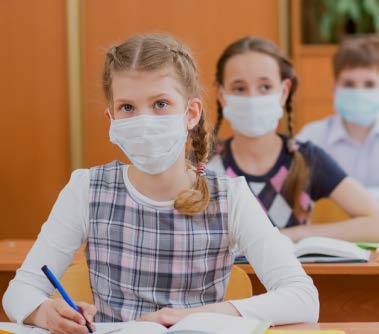Parents and schools are still concerned about the changing landscape of special education during the pandemic. Some districts will be starting ESY (extended school year) in July; some districts are reopening in the fall.
RESTARTING SCHOOL FOR STUDENTS WITH DISABILITIES
SPECIAL CHALLENGES CONTINUE
BY LAUREN AGORATUS, M.A.
What Will Reopening Schools Look Like?
What Will Reopening Schools Look Like? This will depend upon what it happening in each state. In the hardest hit states like New York and New Jersey, there will be delays. The CDC (Centers for Disease Control and Prevention) has recommended guidelines, but some districts are concerned that they may be difficult to implement. Per CDC:
• Lowest Risk: Students and teachers engage in virtual-only classes, activities, and events.
• More Risk: Small, in-person classes, activities, and events. Groups of students stay together and with the same teacher throughout/across school days and groups do not mix. Students remain at least 6 feet apart and do not share objects (e.g., hybrid virtual and in-person class structures, or staggered/rotated scheduling to accommodate smaller class sizes).
• Highest Risk: Full-sized, in-person classes, activities, and events. Students are not spaced apart, share classroom materials or supplies, and mix between classes and activities.

Some suggestions include cancelling all field trips, events, and extracurricular activities. Other ideas include spacing desks 6 feet apart and distancing students on buses. These may be impractical for districts that have large populations and class sizes. Still other recommendations include closing cafeterias and playgrounds, which would put students in the classroom all day. Lastly, it is recommended to keep the same group of students in the same room, which would be difficult to implement in a typical middle or high school as well as for students with disabilities who may have pull-out instructional or related services, or a mix of general and special education classes. The CDC also has good recommendations for disinfecting schools, and protocols if a student or staff member shows symptoms, etc. (see Resources). Some states, like New Jersey, are surveying parents to determine the needs of their students.
91 Questions
District administrators are concerned about reopening schools safely. One administrator posed 91(!) questions on how to proceed. Considerations included:
- • Who determines acceptable risk?
- • What are the criteria/parameters to reopen?
- • Will there be testing guidelines for staff and students? What if someone tests positive?
- • Will staff and students have to wear masks? If so, who is responsible for providing PPE (personal protective equipment)?
- • Will accommodations be made for families who want to keep their child home?
- • Will virtual learning continue?
- • How will this affect afterschool programs like childcare? Extracurricular activities?
- • How will this affect transportation (e.g. social distancing)?
- • How will IEPs be implemented?
- • How can paraprofessionals assist students hands-on, without increasing risk?
This was later updated to 283 questions! To meet the concerns of parents and the needs of students, there may need to for legislative or regulatory changes. Additional concerns for special education students included sports, camps, and summer programs.

Getting Back to School
Getting Back to School Both families and school districts need to be ready to reopen as soon as it is safe, according to public health officials. But before schools can reopen, plans must be developed regarding school operations, child supports, school personnel, academics, and distance learning. Accommodations are needed for at-risk individuals, including school personnel. Students have experienced trauma due to school closures, not seeing friends, parents losing jobs, etc., and the social-emotional fallout needs to be addressed. The plans that are developed must address the needs of all students, including those of students from low-income backgrounds, students with disabilities, and English language learners. Guidance from the American Academy of Pediatrics (AAP) stresses a holistic approach that includes everything from ensuring deep cleaning of schools to ensure a safe environment, to preparing for an addressing the needs of students and staff. "Schools should be attuned to the broader social and family stressors that may affect a student's ability to attend school or be ready to learn," the AAP guidance says.
Medically Fragile Students
Special consideration needs to be given to students with chronic conditions or medical complexity. The CDC guidelines have options such as remote learning, phase-in, or delayed reentry to school. Students with medical needs can have an Individual Health Plan attached to their IEP or 504 Plan. For more information on IHPs, see EP's previous article on this topic at ep- magazine.com/blog/children-with-special-healthcare-needs-require-individual-health-plans-in-ieps504s.
Children with disabilities are still entitled to FAPE (free, appropriate public education). Some students may need compensatory services to catch up. Students who were in their last year of eligibility for special education services are likely to need compensatory services before graduating.
If families need help with their child's school district, they can contact the Parent Center in their state or territory. Considerations of the needs of all students is important to safely reopen schools.•
ABOUT THE AUTHOR:
Lauren Agoratus, M.A. is the parent of a young adult with multiple disabilities. She serves as the State Coordinator for Family Voices-NJ and as the central/southern coordinator in her state's Family-to-Family Health Information Center. FVNJ and F2FHIC are both housed at the SPAN Parent Advocacy Network (SPAN) at spanadvocacy.org